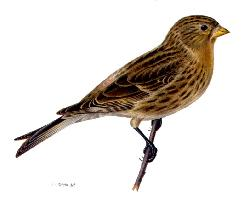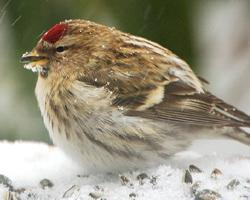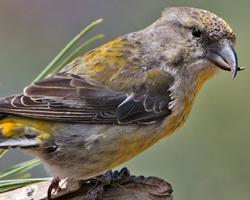
Description de l'animal
The Twite (Linaria flavirostris) is a small, finch-like bird, belonging to the family Fringillidae, which is known for its diverse array of seed-eating birds. This rather inconspicuous bird measures about 13 to 14.5 centimeters in length, with a wingspan ranging from 20 to 22.5 centimeters, and weighs approximately 15 to 22 grams. Its size and appearance are somewhat similar to the Linnet, but it can be distinguished by its shorter tail and different plumage characteristics.The Twite is characterized by its streaky brown back and flanks, which provide excellent camouflage against its natural habitat. Unlike many other finches, the Twite does not exhibit strong sexual dimorphism, meaning that males and females look quite similar. However, during the breeding season, the male Twite's bill turns a bright yellow, making it easier to distinguish from the female, whose bill remains a duller color. Both sexes display a pale pink rump, which is particularly noticeable in flight and serves as a distinctive feature of the species.
This bird's diet primarily consists of seeds from a variety of grasses and small plants. During the breeding season, they may also consume small insects to supplement their diet, which is essential for the growth and development of their chicks.
Twites are known for their nomadic lifestyle outside the breeding season, wandering in flocks in search of food. Their breeding habitat is largely confined to the upland moors and coastal marshes of the British Isles, Scandinavia, and across parts of Russia and Central Asia. They prefer open landscapes where they can nest on the ground, hidden among grasses and other vegetation, making their nests from grass, moss, and small twigs, and lining them with finer materials like feathers.
The song of the Twite is a distinctive, continuous twittering, which has been described as a less musical version of the Linnet's song. Their call, a sharp "twit", is believed to be the origin of their common name.
Twites face several threats, including habitat degradation due to agricultural expansion and intensification, which reduces their breeding and feeding grounds. Climate change also poses a significant threat by altering their habitat and the availability of food sources. Consequently, the Twite has experienced notable declines in parts of its range and is considered of conservation concern in several regions.
Efforts to conserve the Twite focus on protecting and managing their natural habitats, promoting environmentally friendly farming practices that preserve the bird's food sources, and monitoring populations to track their status and implement conservation actions where needed. Despite these challenges
Animaux similaires
Nouvelles photos d'animaux
Top 10 des animaux
- Dolphin gull (Leucophaeus scoresbii)
- Diana monkey (Cercopithecus diana)
- Moustached guenon (Cercopithecus cephus)
- Galápagos tortoise (Geochelone nigra complex)
- Japanese macaque (Macaca fuscata)
- Stone loach (Barbatula barbatula)
- Russian tortoise (Testudo horsfieldii)
- Greek tortoise (Testudo graeca)
- Common flying dragon (Draco volans)
- Vendace (Coregonus albula)


